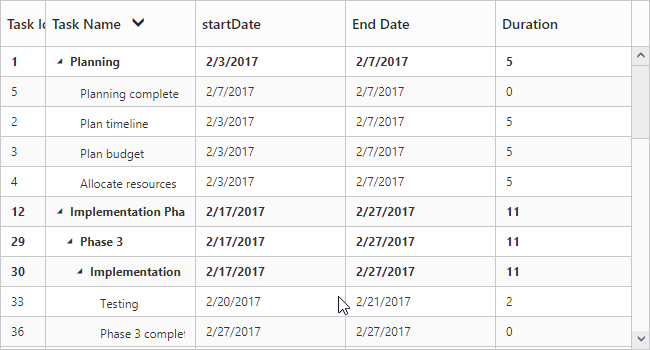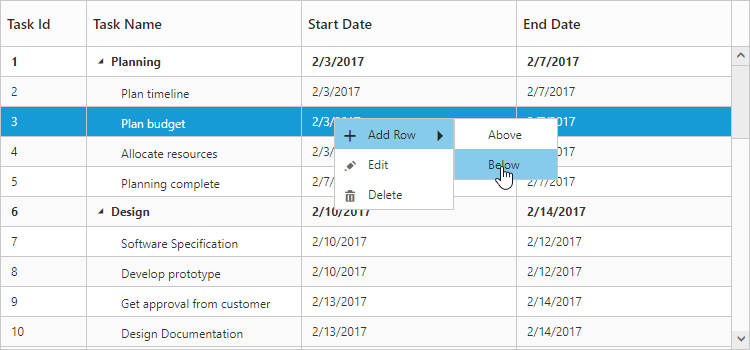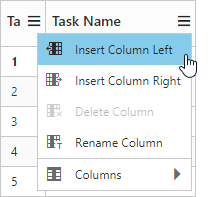Getting Started with ASP.NET Webforms TreeGrid
21 Mar 202214 minutes to read
Create your first TreeGrid in ASP.NET
This section explains briefly about the control structure and how to create a TreeGrid
-
First create a new ASP.NET Web Forms project; please refer the ASP-Getting Started documentation to create new project and add necessary DLL’s and script files.
-
Create a data source in aspx.cs of default file, we can bind data source to TreeGrid using
DataSourceproperty. -
Add the following code example in the default.aspx file to create a TreeGrid control.
<form id="form1" runat="server">
<ej:TreeGrid runat="server" ID="TreeGridControlDefault" ChildMapping="Children" TreeColumnIndex="1">
<columns>
<ej:TreeGridColumn HeaderText="Task Id" Field="TaskId" Width="45" />
<ej:TreeGridColumn HeaderText="Task Name" Field="TaskName" />
<ej:TreeGridColumn HeaderText="Start Date" Field="StartDate" />
<ej:TreeGridColumn HeaderText="End Date" Field="EndDate" />
<ej:TreeGridColumn HeaderText="Duration" Field="Duration" />
</columns>
</ej:TreeGrid>
</form>protected void Page_Load(object sender, EventArgs e)
{
TaskDetailsCollection TasksCollection = new TaskDetailsCollection();
this.TreeGridControlDefault.DataSource = TasksCollection.GetData();
this.TreeGridControlDefault.DataBind();
}
public class TaskDetailsCollection
{
public List<BusinessObject> GetData()
{
List<BusinessObject> dataCollection = new List<BusinessObject>();
BusinessObject Record1 = new BusinessObject()
{
TaskId = 1,
TaskName = "Planning",
StartDate = "02/03/2017",
Duration = 5,
Children = new List<BusinessObject>(),
};
BusinessObject Child1 = new BusinessObject()
{
TaskId = 2,
TaskName = "Plan timeline",
StartDate = "02/03/2017",
Duration = 5
};
BusinessObject Child2 = new BusinessObject()
{
TaskId = 3,
TaskName = "Plan budget",
StartDate = "02/03/2017",
Duration = 5
};
BusinessObject Child3 = new BusinessObject()
{
TaskId = 4,
TaskName = "Allocate resources",
StartDate = "02/03/2017",
Duration = 5
};
BusinessObject Child4 = new BusinessObject()
{
TaskId = 5,
TaskName = "Planning complete",
StartDate = "02/07/2017",
Duration = 0
};
Record1.Children.Add(Child1);
Record1.Children.Add(Child2);
Record1.Children.Add(Child3);
Record1.Children.Add(Child4);
BusinessObject Record2 = new BusinessObject()
{
TaskId = 6,
TaskName = "Design",
StartDate = "02/10/2017",
Duration = 3,
Children = new List<BusinessObject>(),
};
BusinessObject Child5 = new BusinessObject()
{
TaskId = 7,
TaskName = "Software Specification",
StartDate = "02/10/2017",
Duration = 3
};
BusinessObject Child6 = new BusinessObject()
{
TaskId = 8,
TaskName = "Develop prototype",
StartDate = "02/10/2017",
Duration = 3
};
BusinessObject Child7 = new BusinessObject()
{
TaskId = 9,
TaskName = "Get approval from customer",
StartDate = "02/13/2017",
Duration = 2
};
BusinessObject Child8 = new BusinessObject()
{
TaskId = 10,
TaskName = "Design complete",
StartDate = "02/14/2017",
Duration = 0
};
Record2.Children.Add(Child5);
Record2.Children.Add(Child6);
Record2.Children.Add(Child7);
Record2.Children.Add(Child8);
dataCollection.Add(Record1);
dataCollection.Add(Record2);
return dataCollection;
}
}
public class BusinessObject
{
public int TaskId { get; set; }
public string TaskName { get; set; }
public string StartDate { get; set; }
public int Duration { get; set; }
public List<BusinessObject> Children { get; set; }
}
Simple TreeGrid
Enable Toolbar
TreeGrid control contains the toolbar options to Add, Edit, Delete, Cancel, Update, Search, ExpandAll and CollapseAll operations, you can enable the toolbar by using ToolbarSettings property.
<ej:TreeGrid runat="server" ID="TreeGridContainer" >
<ToolbarSettings ShowToolbar="true" ToolbarItems="add,edit,delete,update,cancel,expandAll,collapseAll,search" />
</ej:TreeGrid>The following screen shot displays a Toolbar in TreeGrid.

Toolbar in TreeGrid
NOTE
Add, Edit, Delete options are enabled by
AllowEditing,AllowAdding,AllowDeletingin theEditSettings.
Click here to refer more details for TreeGrid ToolbarSettings.
Enable Sorting
The TreeGrid control contains sorting functionality to arrange the data in ascending or descending order based on a particular column.
Multicolumn Sorting
You can enable the multicolumn sorting in TreeGrid by setting AllowMultiSorting as true .You can sort multiple columns in TreeGrid by selecting the desired column header when holding the CTRL key.
<ej:TreeGrid runat="server" ID="TreeGridContainer" AllowSorting="true" AllowMultiSorting="true">
</ej:TreeGrid>
Click here to refer more details for TreeGrid Sorting.
Enable Editing
You can enable editing in TreeGrid by using EditSettings property and it is illustrated in the following code example.
<ej:TreeGrid runat="server" ID="TreeGridContainer">
<EditSettings AllowEditing="true" AllowAdding="true" AllowDeleting="true" EditMode="CellEditing" />
</ej:TreeGrid>
Click here to refer more details for TreeGrid Editing.
Enable Context Menu
The Context menu in TreeGrid control is used to manipulate (add, edit and delete) the TreeGrid rows.
In TreeGrid, context menu can be enabled by ContextMenuSettings property. The ContextMenuSettings property contains two inner properties ShowContextMenu and ContextMenuItems.
<ej:TreeGrid runat="server" ID="TreeGridContainer">
<ContextMenuSettings ShowContextMenu="true" ContextMenuItems="add,edit,delete" />
</ej:TreeGrid>The following screenshot displays the context menu in TreeGrid control.

TreeGrid with context menu
Click here to refer more details for TreeGrid context menu.
Enable Column Menu
You can enable the column menu in TreeGrid, by setting the ShowColumnChooser as true.
<ej:TreeGrid runat="server" ID="TreeGridContainer" ShowColumnChooser="true" AllowSorting="true" AllowMultiSorting="true">
</ej:TreeGrid>The following screenshot displays the column chooser in TreeGrid control.

TreeGrid with column chooser
Define dimension of TreeGrid
By default TreeGrid control was rendered with 100% width and 450px height, we can define the dimension of TreeGrid control by using SizeSettings property. TreeGrid control width and height can be defined by either Height and Width properties or by defining inline style in TreeGrid container element. The below code example shows how to define width and height for TreeGrid control.
<ej:TreeGrid runat="server" ID="TreeGridContainer">
<SizeSettings Width="700px" Height="350px" />
</ej:TreeGrid>NOTE
1.TreeGrid control will automatically update the width and height value based on container element on window resize action, this can be enabled by setting
IsResponsiveproperty astruefor thisHeightandWidthvalue will be defined in percentage.
2.We can also render TreeGrid with auto height by settingSizeSettings.Heightasauto.